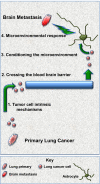Why does Jack, and not Jill, break his crown? Sex disparity in brain tumors
- PMID: 22277186
- PMCID: PMC3293746
- DOI: 10.1186/2042-6410-3-3
Why does Jack, and not Jill, break his crown? Sex disparity in brain tumors
Abstract
It is often reported that brain tumors occur more frequently in males, and that males suffer a worse outcome from brain tumors than females. If correct, these observations suggest that sex plays a fundamental role in brain tumor biology. The following review of the literature regarding primary and metastatic brain tumors, reveals that brain tumors do occur more frequently in males compared to females regardless of age, tumor histology, or region of the world. Sexually dimorphic mechanisms that might control tumor cell biology, as well as immune and brain microenvironmental responses to cancer, are explored as the basis for this sex disparity. Elucidating the mechanisms by which sex chromosomes and sex hormones impact on brain tumorigenesis and progression will advance our understanding of basic cancer biology and is likely to be essential for optimizing the care of brain tumor patients.
Figures



References
-
- Kohler BA, Ward E, McCarthy BJ, Schymura MJ, Ries LA, Eheman C, Jemal A, Anderson RN, Ajani UA, Edwards BK. Annual report to the nation on the status of cancer, 1975-2007, featuring tumors of the brain and other nervous system. J Natl Cancer Inst. 2011;103:714–736. doi: 10.1093/jnci/djr077. - DOI - PMC - PubMed
-
- Pollack IF. Multidisciplinary management of childhood brain tumors: a review of outcomes, recent advances, and challenges. J Neurosurg Pediatr. pp. 135–148. - PubMed
Grants and funding
LinkOut - more resources
Full Text Sources

